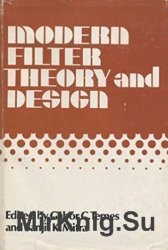Modern Filter Theory and Design
- Добавил: alex66
- Дата: 25-11-2018, 21:26
- Комментариев: 0

Название: Modern Filter Theory and Design
Автор: Editors Gabor C. Temes, Sanjit K. Mitra
Издательство: John Wiley & Sons
Год: 1973
Формат: PDF
Страниц: 578
Размер: 134.86 МБ
Язык: English
The theory of filters owes its origin to Wagner and Campbell, who in 1915 advanced the concept of passive electric wave filters. Since then, the theory and practice of filter design has advanced considerably with a consequent broadening of the term “filter”. Presently, a filter is more or less defined as a network which is required to have a prescribed response for a given excitation. The response requirement may be given either in terms of time or frequency; in the latter case, usually selectivity is implied.
The theory of passive lumped filters, more commonly known as classical filter theory, has received the most attention during the last fifty years. The initial highly successful image-parameter theory has been gradually replaced by the more efficient insertion-loss theory of Cauer, Darlington, and Piloty. This process was accelerated by the increasing availability of high-speed digital computers, which has made it possible to implement economically filter-design techniques based on the latter, more complex, approach. In many applications, filters with sharply selective attenuation characteristics are needed. This necessitates the use of crystal and ceramic elements. Due to the complex models of these devices, a special theory had to be developed for design purposes. In the microwave range, the network elements are of a distributed nature and again require special design methods. However, some of the basic techniques used here evolved from the classical filter theory.
Probably the most significant recent impact on the progress of filter design and theory came from modern advances in micro-electronics. These led to the rapid development of inductorless active filters with lumped and distributed elements, of N-path filters and of digital filters. The development of digital transmission systems also required filters to work with switches— the theory of resonant transfer filters was thus born. In all of these new approaches to filter design, the computer has played an increasingly important role, and often new techniques have been developed either to take advantage of the high speed of modern-day computers or to get around the inherent limitations of digital computers.
The purpose of this book is to present the basic theory and some of the more important design techniques used in each of the above approaches to filter design.
Внимание
Уважаемый посетитель, Вы зашли на сайт как незарегистрированный пользователь.
Мы рекомендуем Вам зарегистрироваться либо войти на сайт под своим именем.
Уважаемый посетитель, Вы зашли на сайт как незарегистрированный пользователь.
Мы рекомендуем Вам зарегистрироваться либо войти на сайт под своим именем.
Информация
Посетители, находящиеся в группе Гости, не могут оставлять комментарии к данной публикации.
Посетители, находящиеся в группе Гости, не могут оставлять комментарии к данной публикации.
